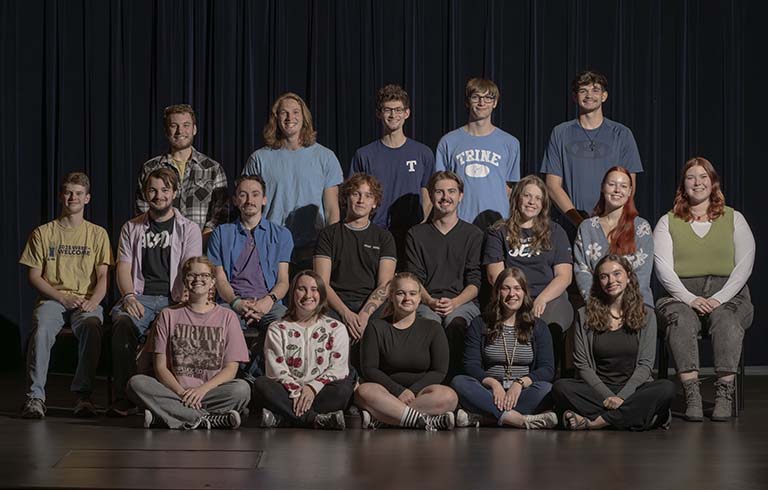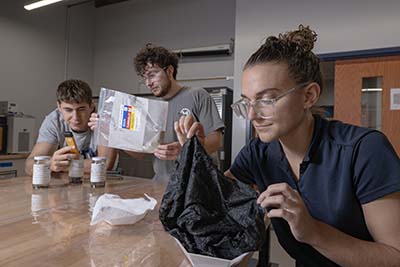
Trine Theatre announces cast for ‘Murder on the Orient Express’
Trine University Theatre has announced the cast and crew for its upcoming production of “Murder on the Orient Express,” by Agatha Christie.
May 14, 2025

Lydia Randolph of Jefferson, Ohio, Marshall Beebe of Nappanee, Indiana, and Joshua Scott of Ossian, Indiana, focused their capstone work on enhancing filtration performance at Copperworks, where recent plant growth has exceeded the capacity of the existing system.
Their project combined design innovation with hands-on testing to propose both immediate upgrades and long-term solutions for improving soot removal.
“This project gave us the opportunity to explore multiple facets of engineering—from lab testing and vendor coordination to in-plant experimentation and system design,” said Randolph. “That diversity made it especially engaging.”
From the lab to the line
The students worked closely with Copperworks staff throughout the year.
After establishing a project direction that included both system optimization and new equipment design, the team ran extensive small-scale lab tests to identify improvements such as better filter paper and flocculant performance. Flocculants are additives that help promote clumping of fine particles into larger aggregates, aiding in their separation and removal.
The lab results were later scaled up and evaluated through plant trials conducted on-site.
“Copperworks gave us the independence to manage much of the project,” Randolph explained, “but they remained closely involved, helping us secure materials and offering feedback through regular updates and plant operator input. That collaboration shaped our decisions and gave us practical insight into plant operations.”
Copperworks Process Engineer and Industry contact, Roger Chase, was impressed with the group’s problem-solving ability.
“The Trine design team was able to effectively navigate not only the technical aspects of the project, but also the unforeseen complications that come with testing on an active production line and complete a financial analysis,” he said.
The team’s proposed improvements include implementing a more durable turbidity meter, optimizing flocculant dosing and designing a new hydrocyclone-based filtration system to better fit the plant’s spatial constraints. These recommendations are expected to reduce maintenance demands and operational costs while boosting efficiency.
“This project provided Copperworks with cost-saving enhancements to their current system and a scalable path forward through the hydrocyclone design,” said Scott.
Design and experimentation
Throughout the project, students balanced experimentation with engineering design—a unique element of their work.
“We weren’t just handed a single objective,” said Beebe. “We had the freedom to explore different directions, whether that meant testing new flocculants or designing a completely new system. It really felt like we were doing engineering work.”
The project also reinforced concepts learned in the classroom. “We applied principles of fluid dynamics, safety analysis and process design,” said Scott.
All three students also participated in undergraduate research projects during their time at Trine, which provided them unique insights on troubleshooting experimental testing.
“These academic experiences played a vital role in guiding us toward cost-effective, data-driven solutions," Scott added.
Implementing recommendations
Copperworks is in the process of implementing many of the team’s recommendations, including the purchase and installation of new process monitoring equipment and completing additional plant trials for the new filtration method.
“I don’t know of a way to express the value of working with this design group better than actively pursuing the recommendations made by the team,” concluded Chase, who plans to continue working with Trine for future projects.
All three students are launching full-time engineering careers after graduation—two with Abbott Nutrition and Randolph continuing her work with Copperworks. Their involvement in the project gave them valuable early experience in tackling complex challenges and working in professional environments.
“This project gave me a head start on identifying improvements and developing practical solutions—exactly the kind of problem-solving I’ll be doing at Abbott,” summarized Scott, who will join the company as a Utilities Engineer.
“As I begin my role as a project engineer, this experience helped me build confidence in collaborating with vendors and people outside of our direct organization to get quotes and information to conduct our design. It strengthened my ability to evaluate areas of continuous improvement and form meaningful professional relationships along the way,” said Beebe.
Randolph added, “Our in-plant testing revealed both progress and challenges. As I return to Copperworks, I’m excited to build on what we’ve done and help drive future improvements.”